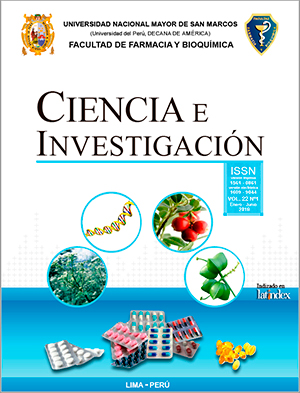Assessment of the anti-inflammatory activity of a gel with extract of calyces of Physalis peruviana “aguaymanto”
DOI:
https://doi.org/10.15381/ci.v22i1.16809Keywords:
Bactris guineensis, cream, centrifugation, stability, gelAbstract
This study was designed in three phases: 1. Preliminary assessment of the extract of calyces. 2. Formulation and assessment of gels incorporating the extract. 3. Assessment of the anti-inflammatory activity of the gel. Objective. To evaluate the anti-inflammatory activity of a gel based on the lyophilized ethanolic extract of calyces of Physalis peruviana “goldenberry”. Methodology. Calyces of goldenberry collected from a processing company in the department of Cuzco were subject of a reflux extraction with petroleum ether and, from the residue, it was prepared an ethanolic extract, by maceration, which was lyophilized and incorporated at concentration of 1 % in different formulations of gel base of sodium carboxymethylcellulose (CMC), polyacrylamide and carbomer. Those preparations that presented better physical compatibility were subjected to preliminary stability. For the assessment of the anti-inflammatory activity, it was chosen the gel in 3 % polyacrylamide, because it showed better results in the preliminary tests, by using an experimental model of induction of inflammation by sub-plantar injection of 0,05 mL of 1 % lambda carragenan in Mus musculus strain Balb/C/CNPB male albino mice. Results. The anti-inflammatory efficacy was 14,83; 39,10 and 48,86 % for the lyophilized ethanolic extract at 1 %, fresh preparation gel and 15-days-aged gel, versus 56,79 and 24,49 % for 1 % diclofenac gel and 0,05 % clobetasol cream, respectively. Conclusions. The evaluated 3 % polyacrylamide gel with 1 % lyophilized extract of Physalis peruviana calyces’ formulation has anti-inflammatory activity.
Downloads
Published
Issue
Section
License
Copyright (c) 2019 Maria R. Vallejo, José R. Juárez, Américo J. Castro, Jorge L. Arroyo

This work is licensed under a Creative Commons Attribution-NonCommercial-ShareAlike 4.0 International License.
LOS AUTORES RETIENEN SUS DERECHOS:
- Los autores retienen sus derechos de marca y patente, y tambien sobre cualquier proceso o procedimiento descrito en el artículo.
- Los autores retienen el derecho de compartir, copiar, distribuir, ejecutar y comunicar públicamente el articulo publicado en la Revista Ciencia e Investigación (por ejemplo, colocarlo en un repositorio institucional o publicarlo en un libro), con un reconocimiento de su publicación inicial en la Revista Ciencia e Investigación.
- Los autores retienen el derecho a hacer una posterior publicación de su trabajo, de utilizar el artículo o cualquier parte de aquel (por ejemplo: una compilación de sus trabajos, notas para conferencias, tesis, o para un libro), siempre que indiquen la fuente de publicación (autores del trabajo, revista, volumen, numero y fecha).






